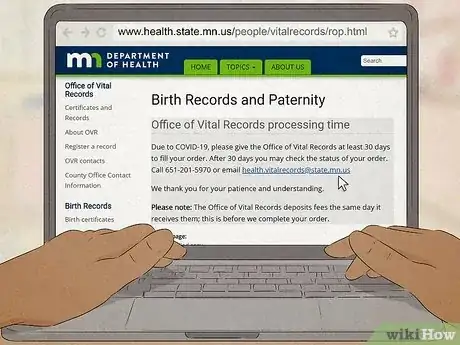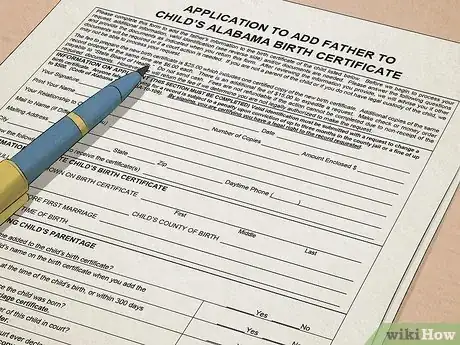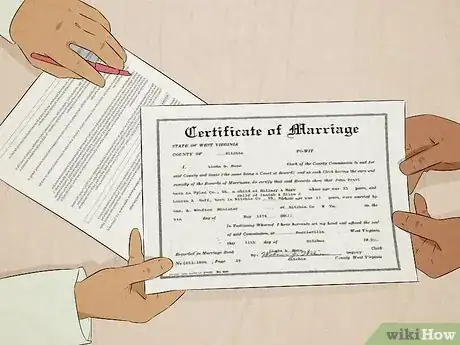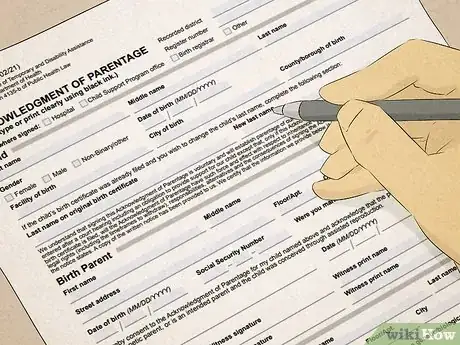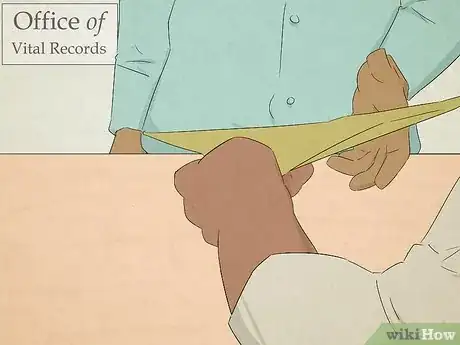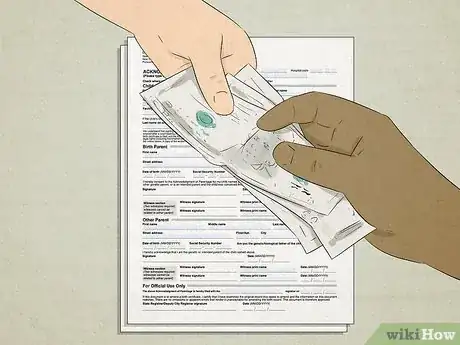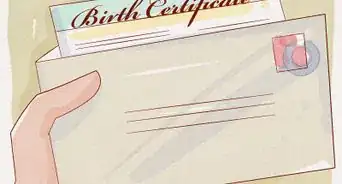This article was co-authored by wikiHow Staff. Our trained team of editors and researchers validate articles for accuracy and comprehensiveness. wikiHow's Content Management Team carefully monitors the work from our editorial staff to ensure that each article is backed by trusted research and meets our high quality standards.
This article has been viewed 47,941 times.
Usually when a child is born, both parents’ names are added to a birth certificate. However, for various reasons, the father’s name sometimes must be added to the birth certificate weeks or months after the mother’s name has been added. The father’s name is typically added in one of two situations: either when the child’s parents are married after the child has been born or when the natural father’s name is added to the certificate, still outside of marriage.
Steps
Completing Paperwork to Alter the Birth Certificate
-
1Navigate online to your state’s Department of Health website. Each state’s Department of Health keeps records detailing births, including birth certificates. The state’s DOH portal should contain information regarding adding the father’s name to the certificate. To find the relevant information on the site, try navigating to the “Vital Records” category. Or, if the site has a search bar, type in something like “change paternity on birth certificate.”
- For example, if you live in Minnesota, the state DOH presents information regarding birth certificate changes.
-
2Fill out a form requesting the addition of the father’s name. Each state should provide online access to the legal form which allows you to formally request the father’s name be added to the birth certificate.[1] The form will ask for your name and other legal information, including the father’s name and the child’s name and date of birth.
- For example, the state of Alabama requires you to fill out a “Request to Add Father to Child’s Alabama Birth Certificate” form. Access the form online at: http://www.alabamapublichealth.gov/vitalrecords/assets/hs75.pdf.
- Similarly, Minnesota requires the father to fill out a “Voluntary Recognition of Parentage Form,” available online at: https://edocs.dhs.state.mn.us/lfserver/Public/DHS-3159-ENG.
-
3Print the form and sign in it front of a notary public. Once you’ve completed the form, print a paper copy. Visit a notary and sign the form in front of them. The notary will then notarize the document. Make sure that the form is clearly printed and has no cross-outs, or the notary may not sign it.
- Check with your bank or other financial institution to see if they have an on-staff notary. Notaries are also commonly found at city or county buildings like city halls or court houses.
- Not all states may require that the form be notarized. Consult the state’s DOH website for clarification.
Presenting Documentation Showing Marriage or Paternity
-
1Present a valid marriage license at the Office of Vital Records. If the child was born outside of marriage but you have since married the child’s father, you’ll need to prove this to the state by presenting a copy of your marriage license.[2]
- You will also need to sign a legal affidavit either in front of the notary or at the Office of Vital Records.
- If you’re mailing in the paperwork, you can include a notarized photocopy of your marriage license in the envelope.
- Only add the name of the child’s biological father to the certificate. If the person you are currently married to is not the child’s biological father, their name shouldn’t appear on the birth certificate.
-
2Complete a paternity request form if you’re not married to the father. You can find this form online through the state DOH or Office of Vital Records website. If you are not married to the child’s father but would like the father’s name printed on the birth certificate, you’ll need to complete paperwork to file a paternity request. This is a legal petition to modify the birth certificate by adding the father’s name as the child’s legal parent.[3]
- For example, if you live in New York state, access the Acknowledgment of Paternity form online at: https://www.childsupport.ny.gov/dcse/aop_forms.html.
- You must have legal proof of biological paternity before filling out the paternity request form. If the paternity is disputed, the form will not be processed and a paternity test may be legally required.
- Once the paternity request has been granted by the state, both of the child’s parents must sign a “paternity acknowledgment form” in the presence of a notary public.
-
3File the form with the state’s Office of Vital Records. In whichever state you’re filing the birth certificate paternity form, you’ll need to submit the paperwork to the Office of Vital Records. Look online to find the Office’s physical location and mailing address.
- This information may also be available through the state’s DOH website. For example, if you’re filing paper work in South Carolina, a list of Vital Records regions can be found at: http://www.scdhec.gov/VitalRecords/Locations/.
- The form will need to be submitted through the mail or in person, not online, since online documents cannot be notarized.
-
4Pay the required processing fee. Most states will require you to accompany your paperwork with a small fee. In some states, you may be able to pay the fee with a credit card online through the state’s website. Otherwise, make out a check for the amount specified and include it with the form when you mail it in or hand-deliver it to the office.
- For example, Alabama requires a $25 fee for a single copy of the corrected birth certificate. Checks should be made out to the “State Board of Health.”[4]
- In Alabama, each additional birth certificate copy requires an additional $6 fee.
References
- ↑ http://www.alabamapublichealth.gov/vitalrecords/birth-certificate-corrections.html
- ↑ http://www.scdhec.gov/VitalRecords/PaternityAndLegitimation/
- ↑ https://www1.nyc.gov/site/doh/services/certificate-corrections.page
- ↑ http://www.alabamapublichealth.gov/vitalrecords/birth-certificate-corrections.html
- ↑ http://www.alabamapublichealth.gov/vitalrecords/birth-certificate-corrections.html
About this article
To add a father’s name to a birth certificate, you’ll need to file a form with your state’s Department of Health, which you should be able to find on their website. You’ll need to fill out the form, print it out, and sign it in front of a notary. If you’ve married your child’s father since the birth, you’ll need to present your marriage license to the Office of Vital Records too. If you’re not married, you’ll have to file a paternity request form, which you can find on your state’s Department of Health or Office of Vital Records website. Once your paternity request has been granted by your state, both parents will need to sign a Paternity Acknowledgement form in the presence of a notary. For more tips, including how to find a notary in your area, read on!
